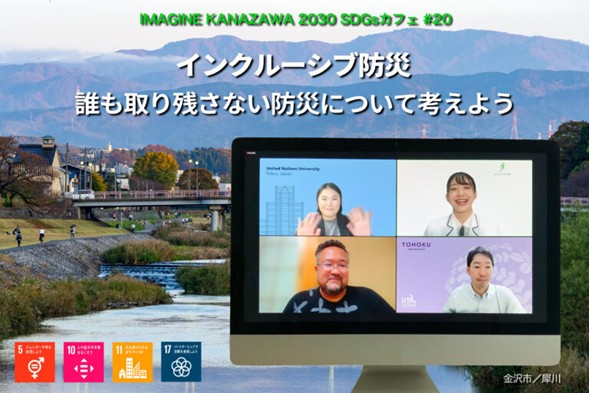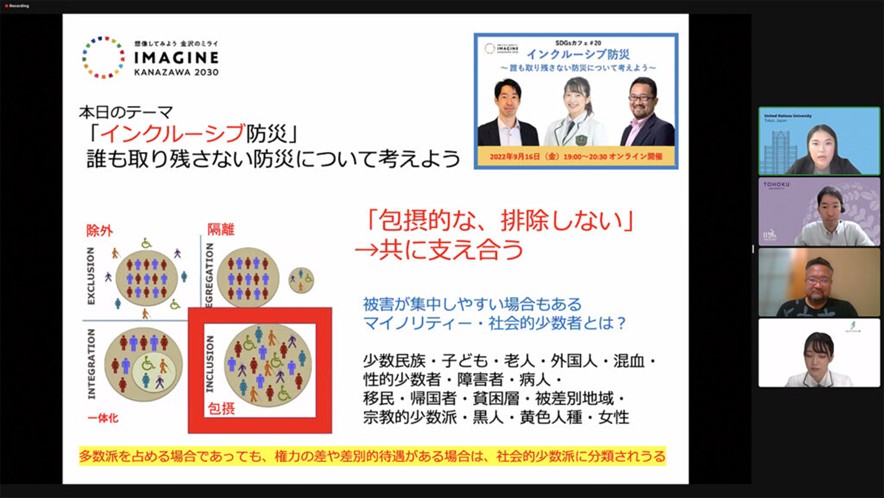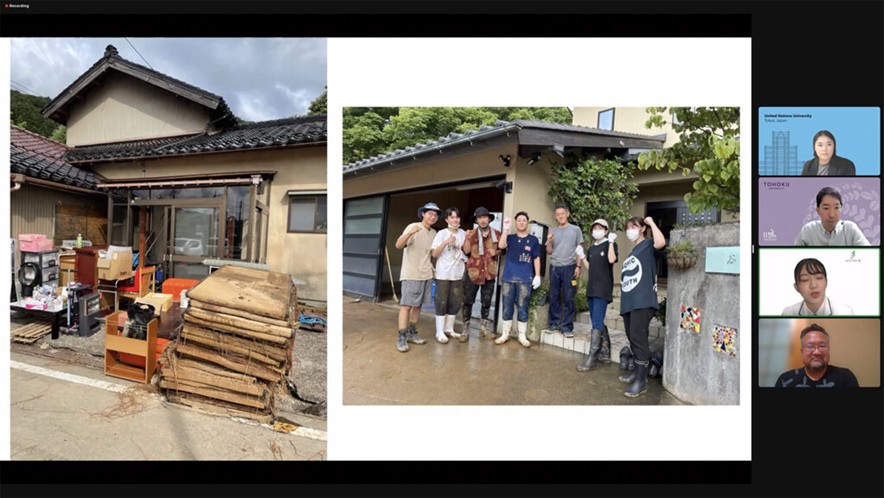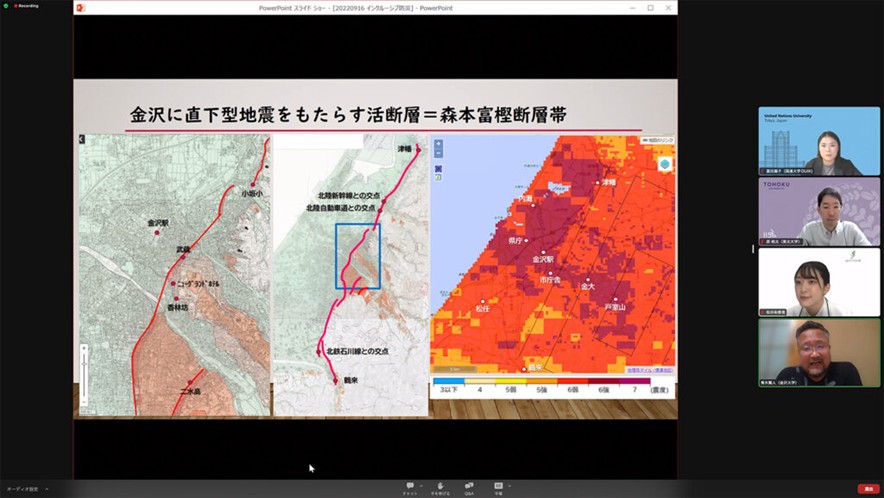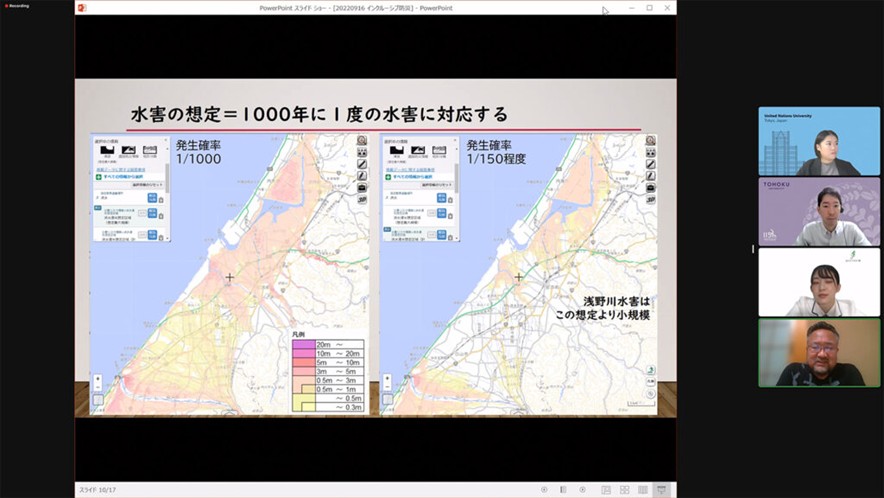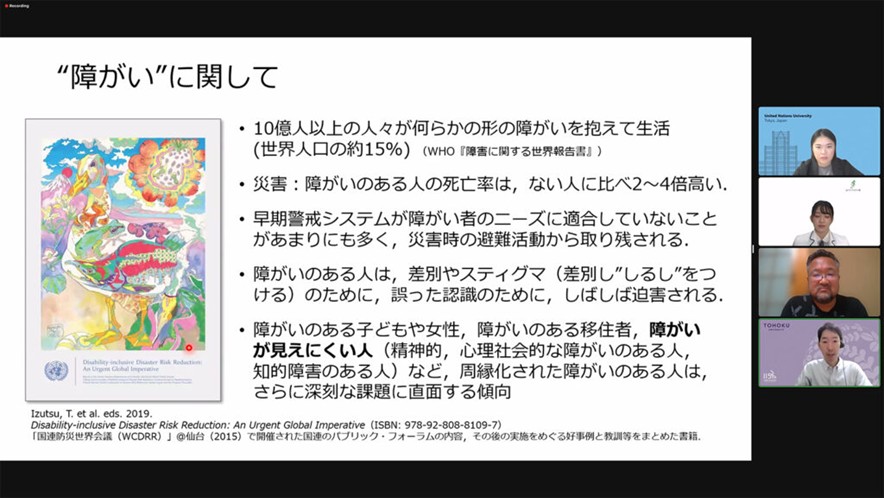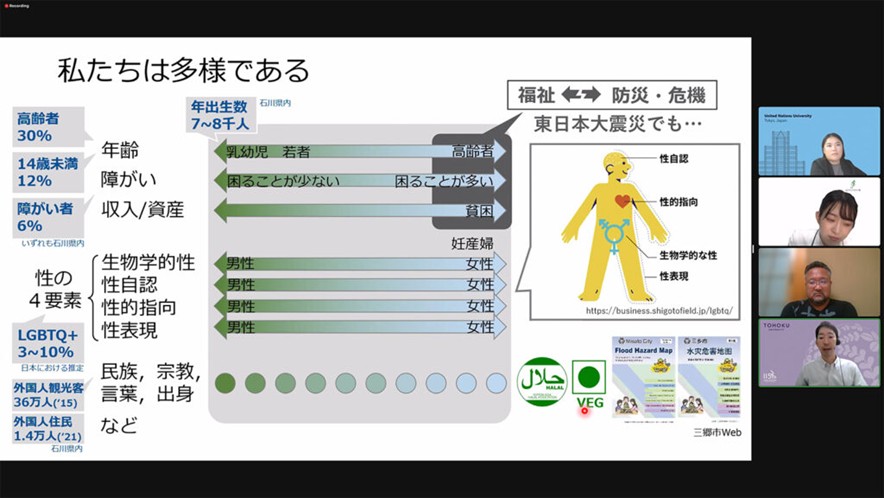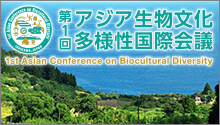What types of disasters, such as earthquakes, tsunamis, and floods, are anticipated in Kanazawa City? Are we fully prepared for these potential disasters? Data indicates that during disasters, vulnerable populations, particularly those needing special consideration and support, often suffer the most. Additionally, issues such as sexual violence and domestic violence, which are difficult to address publicly, tend to increase in evacuation centers.
In this SDGs Café, we deepened our understanding of the disaster risks that could occur in Kanazawa City and the current gaps in our preparedness for “inclusive disaster prevention.”
*This concept, established at the United Nations World Conference on Disaster Risk Reduction held in Sendai, Miyagi Prefecture in March 2015, emphasizes the importance of ensuring that no one, including people with disabilities and the elderly, is left behind during times of disaster.
Thinking on the challenges related to disaster prevention
In Japan, September is designated as the Disaster Prevention Month, and the 20th edition of the SDGs Café, held online after a long hiatus, focused on the theme of inclusive disaster prevention. We were joined by three guest speakers: Yukari Matsui, a disaster prevention specialist and captain of the Hokuriku Idol Club; Tatsuto Aoki, an associate professor at Kanazawa University with expertise in disaster risk and prevention in Ishikawa Prefecture; and Yuta Hara, an assistant professor at Tohoku University involved in international disaster prevention efforts.
First, we asked Ms. Matsui to share her perspective on inclusive disaster prevention from the viewpoint of a disaster prevention expert. During the COVID-19 pandemic, Matsui saw a significant decline in her live performance work and felt the urge to contribute to her community. As a result, she obtained her disaster prevention certification last year.
*For more details about disaster prevention experts, please visit the Japan Bousai Organization.
*Matsui has also shared her journey to obtaining the certification on YouTube: “Steps to Pass the Disaster Prevention Expert Exam: Discussing Costs, Study Methods, and Exam Preparation!” [Ishikawa Prefecture, Kanazawa City].
Matsui, who participated in disaster volunteer activities in Nomi City, which was affected by the heavy rains in August, identified three key challenges related to disaster prevention.
The first challenge is the lack of female disaster prevention experts. The second is that, even when seeing disaster scenes on the news, it can be easy to feel detached, as if it’s someone else’s issue. Matsui mentioned that volunteering for just a few hours can profoundly reveal the hardships faced by those affected. The third challenge is the severe shortage of manpower and the difficulty of communicating what is truly needed.
She emphasized, “It’s not enough to think, ‘I’ll be fine.’ We need a broader range of people—young and old, including those with disabilities and pregnant women—to take an interest in disaster prevention and become disaster prevention specialists. This diversity of perspectives can help uncover various issues.”
Thinking on the disaster risks, measures, and challenges in Kanazawa City from the perspective of inclusive disaster prevention
Professor Aoki shared insights on the disaster risks faced by Kanazawa City, the necessary preparations, and the existing challenges.
Currently, the two major disaster risks anticipated in Kanazawa are earthquakes and flooding. Beneath the city lies the active “Morimoto-Togashi Fault Zone,” which is capable of generating a significant earthquake with an estimated magnitude of 7.2, similar to the Great Hanshin Earthquake. The probability of an earthquake occurring in the next 30 years is projected at 8%, placing it among the top ten based on an analysis of around 200 major active fault lines nationwide. According to Mr. Aoki, “Kanazawa is in a state where a large earthquake is imminent.”
In the event of an earthquake in Kanazawa, the number of people expected to need short-term evacuation is around 190,000. While calculations suggest that the city’s evacuation centers can accommodate about 460,000 people, this estimate is based on standards that fall significantly short of international benchmarks. When recalculated using the international “Sphere Standards,” the capacity drops to approximately 135,000, indicating that there will be people who cannot be accommodated.
Aoki emphasizes that if an earthquake were to occur in Kanazawa, where inclusive disaster prevention plans are currently insufficient, many socially vulnerable individuals would likely struggle within evacuation centers or may not be able to enter them at all. To address these challenges, he stresses the need for a robust evacuation center management plan that incorporates an inclusive disaster prevention perspective.
Regarding flooding, Aoki pointed out that Kanazawa is also facing severe risk assessments. He urged residents to be aware that catastrophic floods, previously thought to occur only once every thousand years, are happening somewhere every year. “Be prepared for the possibility that Kanazawa could be next,” he advised.
Aoki-san introduced three recommended hazard maps:
It is essential to be aware of the various issues that arise on the ground
Mr. Hara, a specialist in inclusive disaster prevention, shared insights on the concept of inclusive disaster prevention, highlighted challenges faced in evacuation centers, and provided advice on how to advance these efforts in Kanazawa.
As diversity increases, it becomes harder to recognize the needs and issues faced by those who are different from ourselves. When decisions are made within a group that shares a limited perspective, important considerations may be overlooked, leading to various problems.
What challenges have emerged on the ground? The “Disaster Prevention Point Book from a Gender Equality Perspective,” published by the Kumamoto City Gender Equality Center “Harmony,” compiles the experiences of those affected by the Kumamoto earthquake. It discusses various issues that became apparent in evacuation centers, affecting women, men, youth, elderly individuals, people with disabilities, foreign residents, and sexual minorities. Here, we present several examples from this resource.
*You can download the booklet from this link
Even when we talk about minorities, in Ishikawa Prefecture, the elderly make up 30% of the population, those under 14 account for 12%, and people with disabilities represent 6%. Additionally, it’s estimated that LGBTQ+ individuals make up around 3-10% of the population in Japan. When we also consider pregnant women and foreigners, the numbers indicate that these groups cannot be dismissed as mere minorities.
“We are diverse, with many different attributes and unique challenges,” says Hara. “It’s crucial to first recognize this diversity. Then, we need to think about how to implement disaster prevention measures that ensure no one is left behind, which is the essence of inclusive disaster prevention.”
The indicators from the “Sendai Framework for Disaster Risk Reduction 2015-2030,” adopted at the Third United Nations World Conference on Disaster Risk Reduction held in Sendai City in 2015, are also integrated into the SDGs related to poverty, urban development, and climate change. He concluded by stating, “Through these efforts, we aim to achieve a society that leaves no one behind, which is also the spirit of the SDGs.”
Large number of questions indicated a high level of interest
During the discussion session, we held a Q&A where many questions arose, such as, “What would happen if a disaster occurred in Kanazawa right now?” and “Can we develop a system using ICT to quickly deliver the necessary support?” This made it clear just how engaged the participants were.
In conclusion, attendees shared their hopes for the future of disaster prevention: Matsui expressed the desire to engage many people so that those around them can have a better understanding of disaster preparedness and a sense of urgency. Aoki stated, “I would be happy if a diverse group of people could be involved in shelter management planning.” Harada added, “I would be glad to contribute to making Kanazawa, where I spent my student days, a better city.”
Ms. Tomita, the session facilitator from the United Nations University OUIK remarked, “I hope we can imagine the various people and the challenges and struggles they face, and with that understanding, we can come together to create a disaster prevention plan that is driven by everyone.” With those thoughts in mind, the SDGs Café came to an end.


